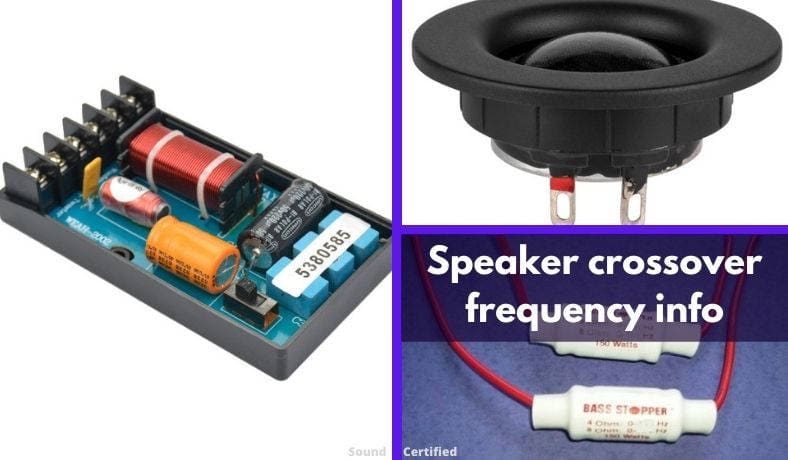Crossovers can definitely be a bit confusing when you’re trying to get the best sound you can. It sure doesn’t help that some speaker manufacturers don’t give clear or helpful information!
In this easy-to-understand article, I’ll explain:
- The important basics of speaker crossovers
- How to determine the speaker crossover frequency you need
- How to tell the frequency for many types of speaker crossovers you’d like to use
- Handy crossover frequency tables you can use right away
Read on to learn what you need to know for better sound.
Contents
What does a speaker crossover do? Why are they helpful?

Speaker crossovers have several functions with the main goal being to improve sound quality:
- Block unwanted sound frequencies that speakers can’t produce well (and that cause distortion or can damage them).
- Split up a musical signal to send certain portions of sound to the speaker best suited for it.
For example, tweeters are sensitive to bass and can’t produce midrange frequencies, so we don’t want to drive them with subwoofer bass especially with high power. A speaker crossover makes blocking this harmful (and distortion-causing) bass possible.
Likewise, other types of speakers such as woofers or subwoofers sound absolutely awful when you drive them with higher frequencies that are best suited for a tweeter. Similarly, we can use a low-pass crossover to filter out (effectively block) that unwanted range of sound for clean, enjoyable sound.
This is especially important for subwoofers as they’re designed for and work best with pure bass only. In that case, a low-pass crossover is used and set to a lower cutoff frequency to get that great sound you love.
Speaker crossovers are very, very common in many home or car speaker systems especially 2-way speaker cabinets or component speaker sets.
How do speaker crossovers work?
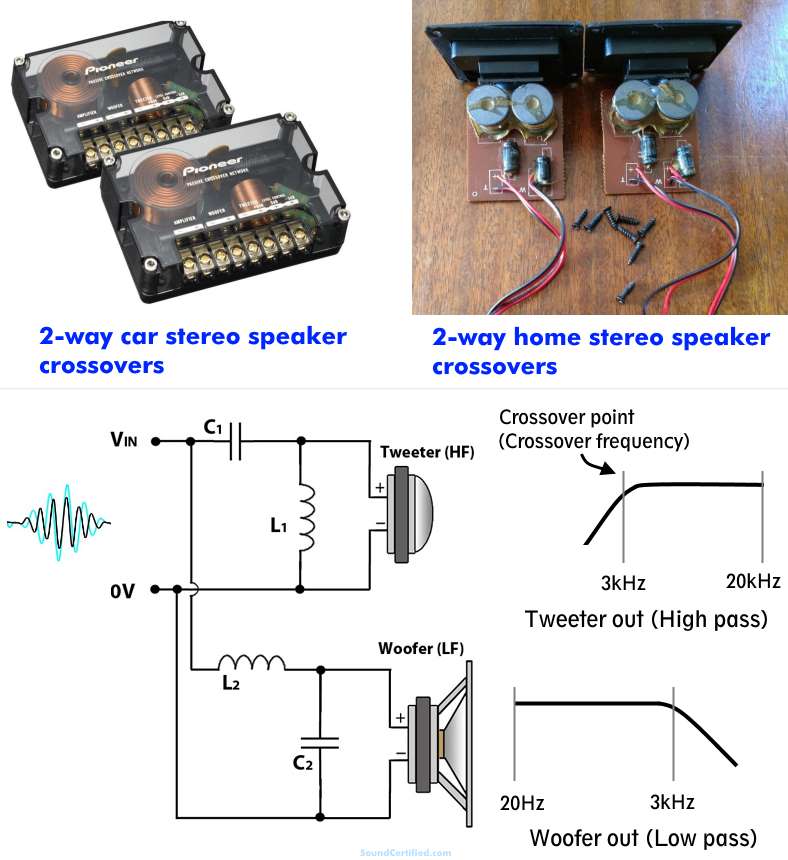
Speaker crossovers work using an interesting behavior found in capacitors and inductors:
- Capacitors pass higher frequencies more easily (as frequency decreases their opposition to the flow of electricity increases). This is due to a principle called capacitive reactance.
- Inductors pass lower frequencies more easily (as frequency increases their opposition to the flow of electricity increases). This is because of inductive reactance.
Capacitors and inductors can be used together to create a more effective filters as well as divide up sound the range of sound produced by a speaker. This is extremely common in 2-way home or car audio speaker systems.
Using mathematical formulas crossover designers can pick the right part values needed for a particular speaker crossover that’s best suited for the speakers to be used.
For example, when lower music frequencies (bass) pass through a high-pass filter the total resistance is very high which means there’s very little output to the speaker. When higher frequencies are present, the resistance is much lower and these signals pass to the speaker without a problem.
What is the speaker crossover point?
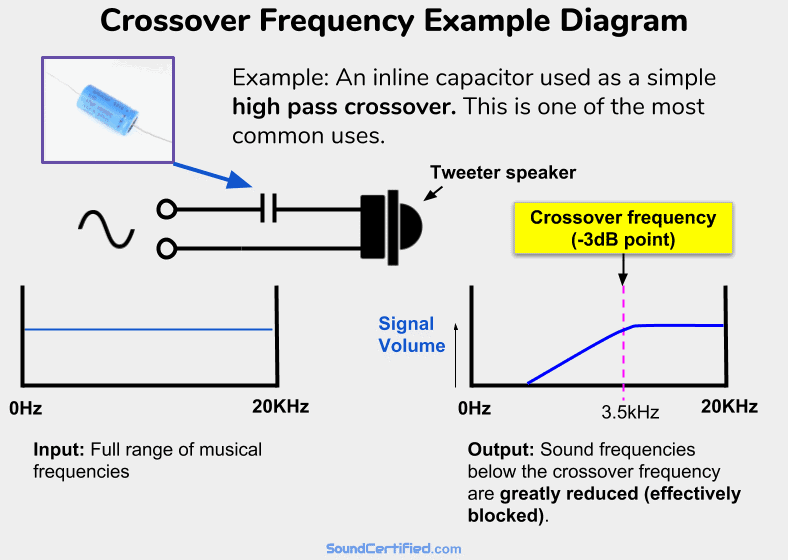
The speaker crossover point is normally called the crossover frequency, often written as “Fc.” The speaker crossover point is the cutoff frequency beyond which audio frequencies are blocked from reaching speakers.
In technical terms, the crossover frequency is found by using the -3 decibel (dB) point from the output of a crossover circuit. In electrical power terms, the 3dB volume reduction point is the frequency at which the power to the speaker is reduced by 1/2.
Past the crossover frequency (the -3dB point) the output will decrease more and more the further away from the cutoff the sound frequency is. For example, for a -6dB per octave high pass crossover, if the cutoff frequency is 1kHz:
- The speaker will have a -3dB output at 1kHz.
- At one octave away (500Hz), the output will be -6dB.
- At frequencies even further away the output will be nearly 0 decibels.
Crossovers aren’t perfect in how they work
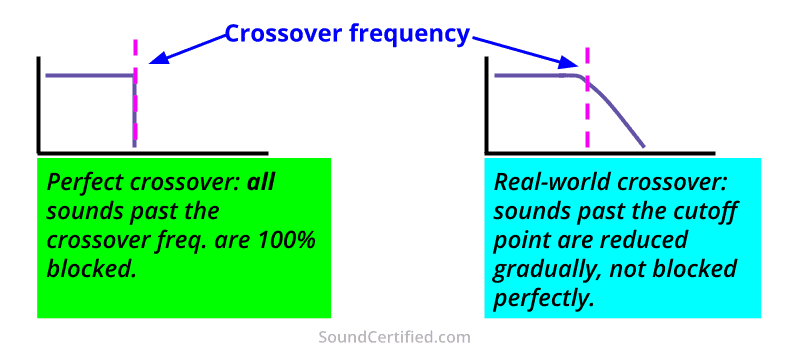
In a perfect world, crossovers would block 100% of the sound you don’t want to reach speakers past that point. However, crossovers aren’t perfect. They attenuate, or reduce, the output of sound past the crossover frequency. Because of this they have a gently curved slope you can visualize on a graph.
Crossover slopes are described in terms of their steepness which describes how effective they are in blocking sound frequencies. They’re listed in terms of dB per octave and always are multiples of 6dB. That’s because crossovers use stages, or sections, each of which uses a single capacitor or inductor with a 6dB reduction for each section.
Example: 60Hz, 120Hz…1KHz, 2KHz, etc.
What are 1st, 2nd, and 3rd order crossovers?
Higher-order crossovers use additional capacitor and inductor sections together that are “stacked” for a more effective cutoff. Higher order crossover use slightly different math but the basic operation is exactly the same.
- -12dB/octave crossovers are some of the most common and are a good compromise between blocking audio frequencies and parts cost. Many car or home amplifiers with a built-in electronic crossover offer a 12dB slope.
- -6dB/octave crossovers are the minimum to use and not as effective as others.
- -18dB and higher order crossovers are much steeper in their cutoff but not necessary in many cases.
When it comes to the crossover point for the speakers themselves it depends on several different things as you’ll see below.
How to determine the crossover frequency for speakers
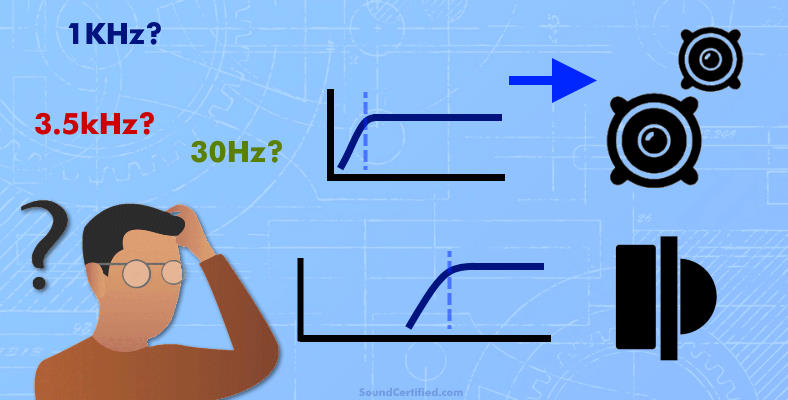
There are a few ways to tell what crossover frequencies you should use with speakers:
- The speaker’s frequency response found in the specifications if provided.
- The type and size of the speakers you have (tweeters vs woofers, small cone vs big cone speakers, etc.).
- Manufacturer recommendations.
In many cases, you’ll end up using 2 or more of the things above to get the best results. To help keep things organized I’ll break the info below into 2 kinds depending on the type of speaker crossover used.
1. Finding the crossover frequency for first-order (inline) crossovers
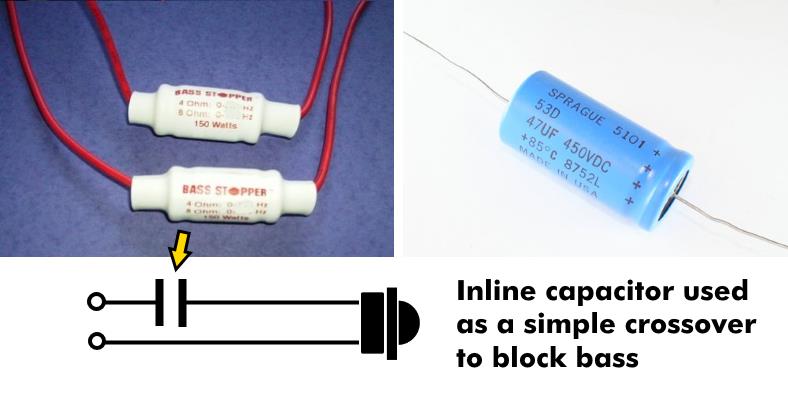
Bass blockers as they’re called are a type of inline 1st order (single stage) crossover used with tweeters or smaller speakers to block bass. If you don’t know the crossover frequency you can calculate it yourself using just a bit of math.
First-order crossovers use a single inline capacitor or inductor. Some of the most common uses are:
- Using an inline capacitor for tweeters or a large capacitor to block bass to small speakers.
- Using an inductor inline to filter out highs to a midrange speaker.
In order to tell what frequency you need (assuming you don’t already know what it is) you can start by checking the speaker’s frequency response rating in the specifications. The problem here is that speaker manufacturers sometimes list the frequencies a speaker can technically produce, not the actual range of sound they can produce well.
Using a frequency response graph
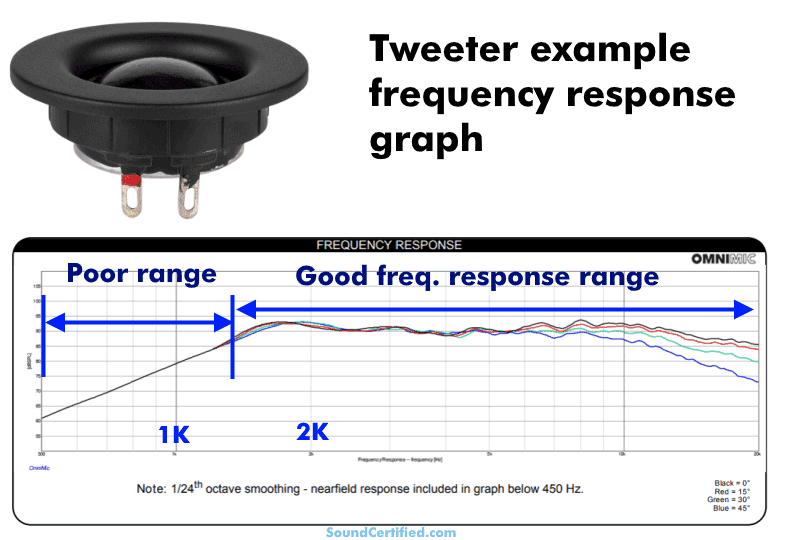
When you have a frequency response graph available you’re able to see the range of sound a speaker can and cannot produce well (such as a much lower sound volume output at the bottom of the graph shown here). Pick a crossover frequency away from this poor range of response.
If you’re lucky enough to have a frequency response graph with the speakers you’d like to use you can see the areas where they have a poor output. These are the areas you’ll want to avoid. To do so, pick a crossover frequency away from this range.
From the example above, we can see that the tweeter shown has a good output until somewhere below 2 kiloHertz (2kHz). Knowing that we’ll want to choose a crossover frequency that’s at least 2kHz or higher.
Using recommended crossover frequencies

Some manufacturers include a recommended frequency range for use. In that case, it’s easy to use this as a guideline. For the example pictured above you’d pick a crossover frequency of at least 3.5kHz which happens to be a very common one.
What to watch out for
Unfortunately, many manufacturers list the frequency response (range) of speakers based on the range of sound they can produce but don’t produce well. For example:
- Small full-range or midrange speakers may be listed as performing down to as low as 35Hz (low-end bass range). However, small speakers almost never can produce lower bass regions well.
- Midrange speakers or general use woofers may be listed as supporting frequencies high into the treble (tweeter) range. For example, 4kHz or even higher. However, woofer or midbass speakers almost never perform well for high frequencies.
In both cases, ignore these unusual higher frequency response ratings and check the response graph if provided.
Because some crossover frequencies are so common I’ve made a table (listed below, next section) that takes the work out of it for you. You can use these as a guide in most cases.
2. Finding the crossover frequency for 2nd order or higher crossovers (2-way or larger speaker systems)
In the case of 2-way or 3-way speaker systems, it’s a little bit more complicated but not by much. In this case, it’s a compromise between the right crossover for both the woofer and the tweeter.
For 2-way or 3-way speaker systems the right crossover frequency is a midpoint that allows them both to work together without a gap in the sound produced. In other words, you’ll want to pick a crossover frequency that allows them both to perform in their optimal range.
2-way speaker crossover example
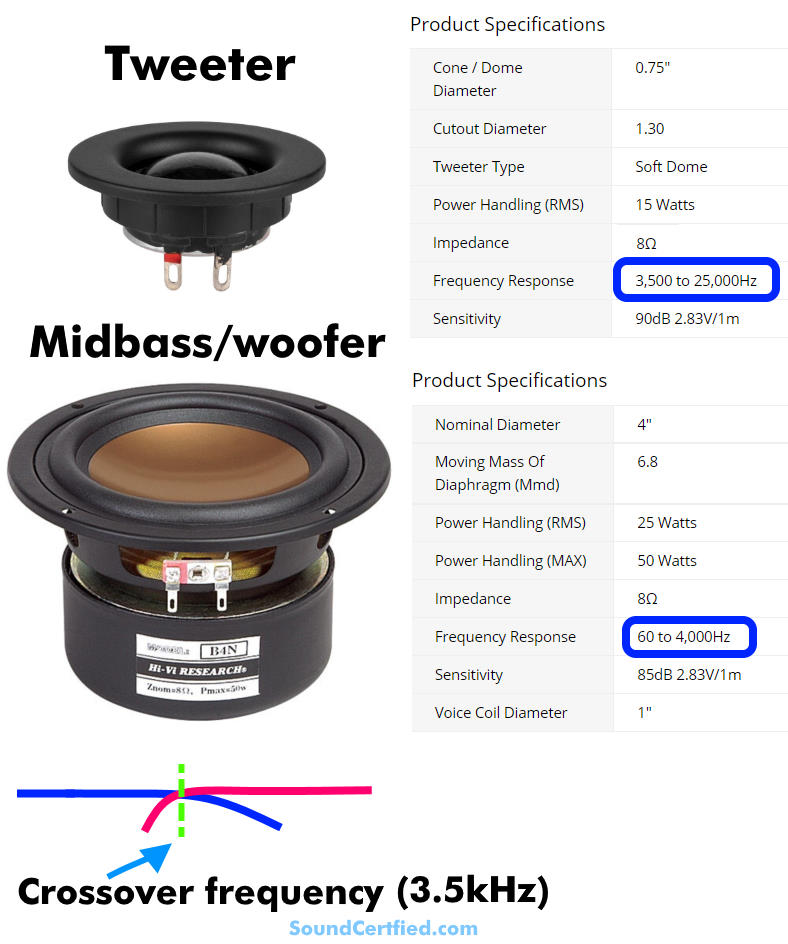
In the example image above you can see some typical speakers along with their recommended use range. To determine the speaker crossover we need we can pick one that’s a combination of:
- Below the maximum recommended frequency for the woofer.
- Above the minimum recommended or specified frequency for the tweeter.
In this case, as often happens, this would be a midpoint around 3,000 Hertz or 3,500 Hertz. We can use either one as ready-made crossover parts are likely available to buy making it easier to put together our own speaker system.
3-way speaker systems
3-way speaker systems are similar to 2-way with the difference being that the middle (midrange) crossover is a bandpass type. Similar to a 2-way speaker set, we’ll pick a midway crossover frequency in the working range of the midrange vs tweeter and the midrange vs woofer as well. (See my recommendations below)
What is a good crossover frequency for speakers? Guidelines & table
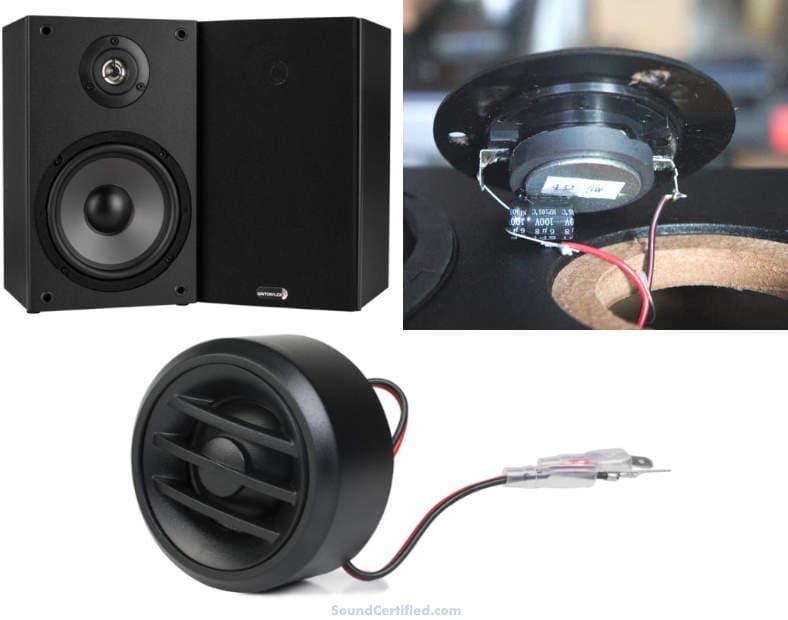
The good news that most of the time you’ll be fine using the most common cutoff frequencies listed below based on the size or type of speaker. That’s because speakers and speaker systems are so often used the same way that the most common cutoff frequencies usually apply.
You can determine crossover frequencies for your speakers, both car or home audio, using the tables I’ve provided below.
Home stereo speaker crossover frequency table
| Speaker type/system | Crossover frequency |
|---|---|
| Subwoofer | 80Hz low pass. (THX sound recommendation also) |
| Main/tower type front speakers (small) | 60 to 80Hz high-pass. Works best with a subwoofer to complement them. |
| Main/tower type front speakers (large) | 40 – 60Hz high-pass. |
| Center or surround sound (small) | 100-120Hz high pass. These types of speakers are very poor for bass. |
| Center or surround sound (medium/large) | 50-60Hz high pass. |
| On-wall or mini satellite speakers | 100-120Hz high pass. |
| 2-way speaker systems | 3kHz to 3.5KHz. Very common crossover frequency |
| 3-way speaker systems | 3.5kHz (mid/treble) & 500Hz (mid/woofer) |
Car stereo speaker crossover frequency table
| Speaker type/system | Crossover frequency |
|---|---|
| Subwoofers | 70-80Hz low pass |
| Front/rear full-range or components | ~56-60Hz high pass to block low bass |
| Tweeters | 3-3.5kHz high pass |
| Midrange or woofer speakers (main) | 1kHz-3.5kHz to block tweeter range sounds |
| 2-way speaker systems | 3kHz to 3.5KHz. Very common crossover frequency |
| 3-way speaker systems | 3.5kHz (mid/treble) & 500Hz (mid/woofer) |
Some general guidelines are:
- For small home or car speakers (4″, 5 1/4″, 6 1/2″ etc) use a high-pass crossover around ~56-60Hz or so to block low-end bass. This will help prevent distortion and you can drive the speakers with more power and volume with great sound clarity.
- Subwoofers need a pure bass signal which you can accomplish by using a low-pass crossover around 70 to 80Hz.
- Tweeters generally are good for around 3kHz or above, so 3kHz or 3.5kHz cutoff frequencies are usually great choices.
How to find the crossover frequency from a speaker crossover
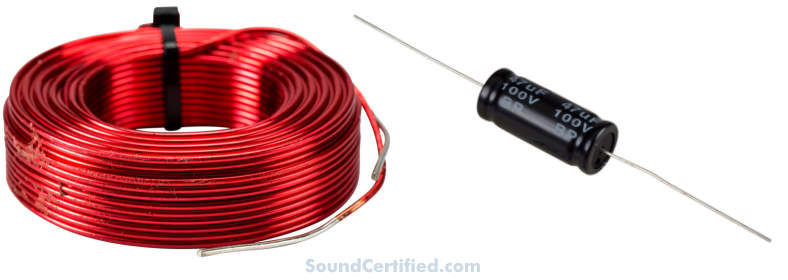
What if you already have a speaker crossover but don’t know what the crossover frequency is? The good news is that in many cases you can figure out what it is based on the part value and the speaker impedance.
To do so, you’ll need to know:
- The value of a capacitor (in Farads) or inductor coil (in Henries) for a single (“1st order”) inline crossover.
- For 2-way or other speaker crossovers it’s very similar but requires a little bit more investigation.
How to determine speaker crossover frequency
1. Single-order (inline) capacitor or inductor crossovers
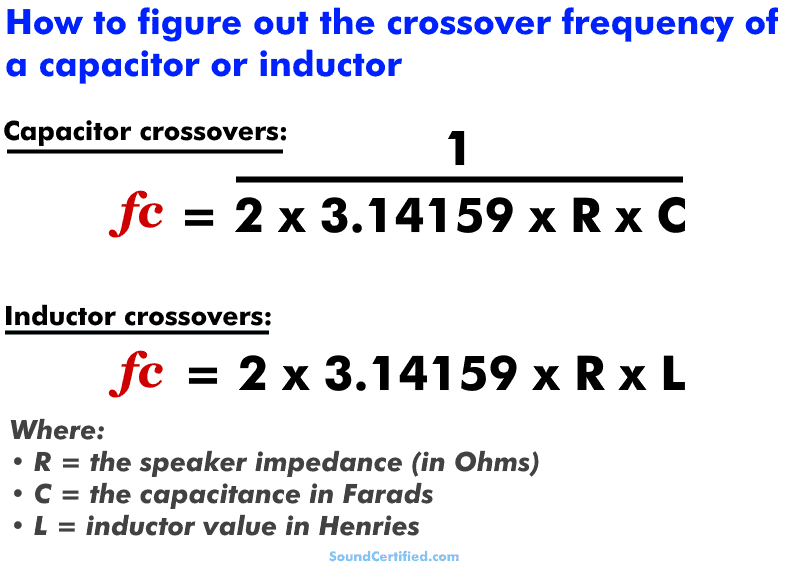
Using the formulas shown above you can calculate the crossover frequency for a given speaker.
For high-pass or low-pass inline crossovers, we can calculate the frequency if we know the speaker Ohms and the capacitance or inductance. It’s the process same in either case.
Speaker impedance = 8Ω, capacitor = 47 microFarads.
Fc = 1/(2 x 3.14159 x 8 x .000047) = 423Hz (about 400Hz).
Speaker impedance = 4Ω, inductor = 4 milliHenries (.004H).
Fc = 4/(2 x 3.14159 x .004) = 159Hz (about 150Hz).
2. 2-way or 3-way crossovers
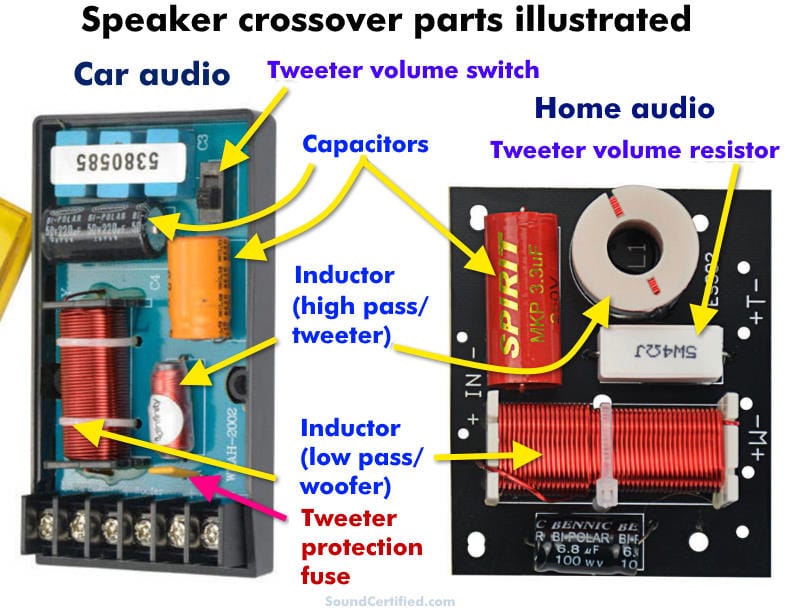
2 and 3-way crossovers are a bit different for a number reasons. Unfortunately, because there are different types and because sometimes manufacturers have different designs or features they can be very hard to figure out sometimes. In other words, there’s no great way to figure out the cutoff frequency for a 2-way or 3-way crossover.
However, there are often a few things you can do to find out the approximate crossover frequency and get it within the “ballpark.” I’ll use a 2-way as an example since they’re so common and because 3-way ones are very similar but with an additional crossover section.
Using test equipment to determine a speaker crossover frequency
If you’re fortunate enough to have test equipment like an oscilloscope and signal generator handy you can apply a signal input to the input side with speakers or resistors of the same Ohms value attached. Gradually change the signal generator frequency and note the point at which the output signal begins to decrease.
When the voltage output decreases by 1/2 that’s the 3dB point and you’ve found the crossover frequency. Unfortunately, most people don’t have access to test equipment so they need a different approach.
Using a speaker crossover calculator and “educated guesses”
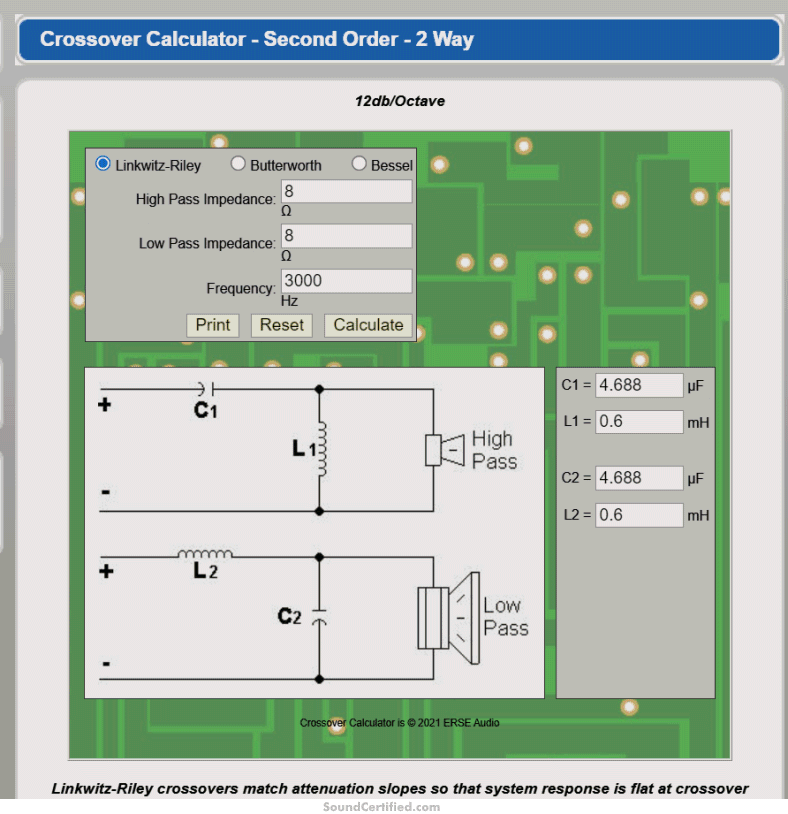
I spent a lot of time trying to figure out various speaker crossovers I’ve owned and unfortunately since they can vary so much it can be extremely hard to figure out their crossover frequency. There are several reasons why:
- Some crossovers reduce the volume on the tweeter by adding an inline resistor. This affects the value of the parts used because the speaker impedance changes how a crossover works.
- The parts installed in a crossover don’t always have their values printed on them.
- Different crossover designs (Linkwitz-Riley, Butterworth, Bessel, etc.) use different values.
- It can be hard to figure out the design of a crossover just by looking at it.
- Some 2- or 3-way crossovers mix 2nd order tweeter and 1st order woofer crossovers in the same design.
My advice is to try picking a best guess crossover frequency from the ones I provided earlier and enter the speaker Ohms values then go from there.
A good (and simple, easy to follow) speaker crossover to use is this one: https://www.erseaudio.com/Second-Order-2-Way
How to use the crossover calculator
For example, start with a whole number like 3,000 Hz for a 2-way crossover for the “best guess” start frequency. Click the button needed to calculate speaker crossover values for the different crossover frequencies.
Check one of the capacitor values (usually those at the top of the circuit board are for the tweeter) and change the crossover frequency by several hundred Hertz if it’s initially way off for the resulting capacitor value shown in the calculated values.
Once you’ve done that, try changing the 3,000 Hz crossover to 2,500 Hz or 3,500 Hz if the capacitor value shown is very different. Once it’s not extremely far off, begin changing it more closely (for example, change it by 250Hz at a time or even 100Hz).
Once you get it relatively close you should have a better idea of what the approximate crossover frequency is. Note that if they’re using a resistor in series with the tweeter output you should add that to the speaker impedance (Ohms) entry box because that makes a difference by twice as much.
(Note: because of the different designs out there, you may need to select Linkwitz-Riley, Butterworth, Bessel, or Chebechev and try those too if available)
